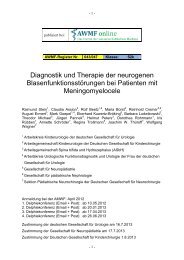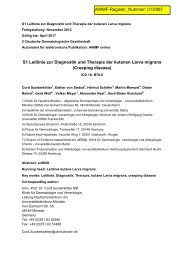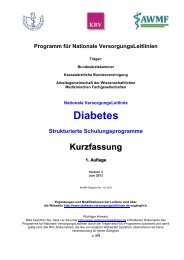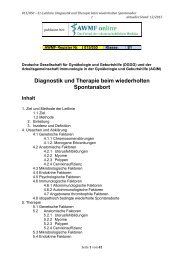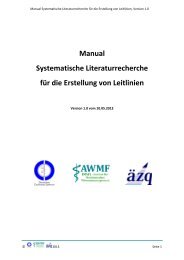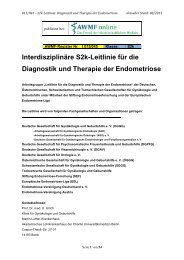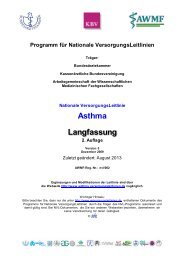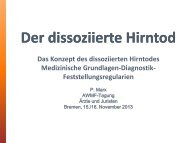Leitlinie „Behandlung der Akne“ - AWMF
Leitlinie „Behandlung der Akne“ - AWMF
Leitlinie „Behandlung der Akne“ - AWMF
Sie wollen auch ein ePaper? Erhöhen Sie die Reichweite Ihrer Titel.
YUMPU macht aus Druck-PDFs automatisch weboptimierte ePaper, die Google liebt.
013/017 - Behandlung <strong>der</strong> Akne aktueller Stand: 02/2010<br />
korrigierte Fassung: 10/2011<br />
18. Schafer T, Nienhaus A, Vieluf D, Berger J, Ring J. Epidemiology of acne in the<br />
general population: the risk of smoking. Br J Dermatol. 2001; 145: 100-4.<br />
19. Cunliffe WJ, Gould DJ. Prevalence of facial acne vulgaris in late adolescence and in<br />
adults. Br Med J. 1979; 1: 1109-10.<br />
20. Poli F, Dreno B, Verschoore M. An epidemiological study of acne in female adults:<br />
results of a survey conducted in France. J Eur Acad Dermatol Venereol. 2001; 15:<br />
541-5.<br />
21. Zouboulis CC, Eady A, Philpott M, Goldsmith LA, Orfanos C, Cunliffe WC,<br />
Rosenfield R. What is the pathogenesis of acne? Exp Dermatol. 2005; 14: 143-52.<br />
22. Zouboulis CC. Mo<strong>der</strong>ne Aknetherapie. Akt Dermatol. 2003; 29: 49-57.<br />
23. Zouboulis CC. Acne: Current aspects on pathology and treatment. Dermatol<br />
Experiences. 1999; 1: 6-37.<br />
24. Chiu A, Chon SY, Kimball AB. The response of skin disease to stress: changes in the<br />
severity of acne vulgaris as affected by examination stress. Arch Dermatol. 2003; 139:<br />
897-900.<br />
25. Zouboulis CC, Bohm M. Neuroendocrine regulation of sebocytes -- a pathogenetic<br />
link between stress and acne. Exp Dermatol. 2004; 13 Suppl 4: 31-5.<br />
26. Melnik BC. Milk--the promoter of chronic Western diseases. Med Hypotheses. 2009;<br />
72: 631-9.<br />
27. Green J, Sinclair RD. Perceptions of acne vulgaris in final year medical student<br />
written examination answers. Australas J Dermatol. 2001; 42: 98-101.<br />
28. Kurokawa I, Danby FW, Ju Q, Wang X, Xiang LF, Xia L, Chen W, Nagy I, Picardo<br />
M, Suh DH, Ganceviciene R, Schagen S, Tsatsou F, Zouboulis CC. New<br />
developments in our un<strong>der</strong>standing of acne pathogenesis and treatment. Exp<br />
Dermatol. 2009.<br />
29. Herane MI, Ando I. Acne in infancy and acne genetics. Dermatology. 2003; 206: 24-<br />
8.<br />
30. Goulden V, McGeown CH, Cunliffe WJ. The familial risk of adult acne: a comparison<br />
between first-degree relatives of affected and unaffected individuals. Br J Dermatol.<br />
1999; 141: 297-300.<br />
31. Walton S, Wyatt EH, Cunliffe WJ. Genetic control of sebum excretion and acne--a<br />
twin study. Br J Dermatol. 1988; 118: 393-6.<br />
32. Kirk KM, Evans DM, Farthing B, Martin NG. Genetic and environmentalinfluences<br />
on acne in adolescent twins. Twin Res. 2001; 4: 190.<br />
33. Bekaert C, Song M, Delvigne A. Acne neonatorum and familial hyperandrogenism.<br />
Dermatology. 1998; 196: 453-4.<br />
34. Ostlere LS, Rumsby G, Holownia P, Jacobs HS, Rustin MH, Honour JW. Carrier<br />
status for steroid 21-hydroxylase deficiency is only one factor in the variable<br />
phenotype of acne. Clin Endocrinol (Oxf). 1998; 48: 209-15.<br />
35. Bataille V, Snie<strong>der</strong> H, MacGregor AJ, Sasieni P, Spector TD. The influence of<br />
genetics and environmental factors in the pathogenesis of acne: a twin study of acne in<br />
women. J Invest Dermatol. 2002; 119: 1317-22.<br />
Seite 107 von 136




